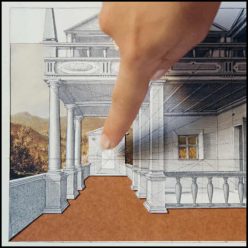IN CLASS TODAY
Non-Photorealistic Rendering
Effectors
Fields
Concepts for Modeling / Sculpting :
- Editable Objects
- Subdivision Surfaces
- Cloth Simulation
ASSIGNMENTS
PRELIMINARY PRESENTATION of FINAL PROJECT
Come to class prepared to do a brief (3 minute) presentation about your idea for a Final Project. Show us one or more images that suggest what your piece will look like. You can also show images that inspire you, or that you are using as a “style reference”. Be ready to describe the FORM and the CONTENT of your project. —
FORM:
— what kind of objects will be in your piece?
— what will the lighting, materials, colors, depth of field look like?
— will your piece be photorealistic, or non-photorealistic?
CONTENT:
— what is the mood of your piece?
— what are some of the meanings of your piece?
— how do you want the viewer to feel when they view your piece?
DESCRIPTION of FINAL PROJECT
You final project should be a set of approximately 10 images made in C4D. The images should work together to make a complete statement.
FORM: You can present your images in one of three possible ways:
- “GRAPHIC NOVEL” LAYOUT : Combine multiple images into a single image, as done in a previous assignment. For example, your project might be 3 images, each containing 4 different images.
- VIDEO : In the style of the film “La Jette”, use your stills to create a video. Give the viewer time to appreciate your image. Try zooms or pans, but do them VERY SLOWLY. You can also reveal a single image slowly, by showing close-ups of different parts of it.
- GALLERY of IMAGES / WEBPAGE : if you send me your images, I will create a webpage for you so they can be viewed as a “carousel” or all laid out in “scroll to view” style.
STRATEGIES — Try to make your set of images really solid, meaning that every single one is necessary to create the meaning of your work. You can try:
- A narrative (clear beginning and end)
- Fragment of a narrative / a hint of narrative
- Non-narrative set of images that amplify each other’s effect. You can think of this as a solo gallery exhibition, where all the works are related by style and theme.
If you are not sure what to work on for your final project… :
- Explore whatever part of C4D is most enjoyable for you — play around and have fun!
- Spend time researching models and materials that might inspire you (check links on the “3D Resources” page of this site).
- Think about work you’ve made in other mediums — how might you bring those strengths into your C4D work? You could do that literally (for example, use scans of your drawings as textures), or conceptually (work with similar themes in C4D).
- Think about the techniques you tried, that you might like to explore more? For example: inserting 3D objects into a real photo; hyper-realistic images; non-photorealistic images.
If you have any question, or if you’d like to get feedback — please contact me via Remind or email
2. READ The Emancipated Spectator (Jacques Ranciere)
This text is a rebuttal to the ideas of Plato, Brecht, and Debord. It is not a simple text. Part of the problem is, Ranciere does a very good job of explaining the ideas of the thinkers he is arguing against — so it can be difficult to tell when he’s making a case for his own position, and when he is building up an idea just so that he can knock it down.
If it’s helpful, here are the ideas that Ranciere is against:
— to be a spectator is to be ignorant
— the theater (performers and audience) is a community
— the artist / the teacher has knowledge that is superior to the audience / students
— theater/art transmits ideas accurately
And here are the ideas Ranciere argues for:
— the “ignorant schoolmaster”
— the “equivalence of intelligences”
— translation, not transmission
— the “equivalence” of looking and acting, or saying and hearing
